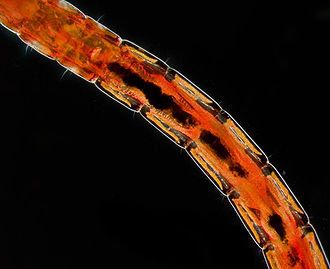Chironomidae




Chironomidae, commonly known as non-biting midges, are a family of nematoceran insects in the order Diptera. They are closely related to the Ceratopogonidae, Simuliidae, and Thaumaleidae. With over 10,000 species described, they are one of the most diverse families of Diptera. Chironomidae larvae are found in a wide variety of aquatic habitats, including freshwater, brackish water, and even saltwater environments. The adults are often seen in large swarms, especially near bodies of water, during the evening.
Description[edit]
Chironomidae species range in size from small to medium, with adults typically measuring 2 to 20 mm in length. They are often mistaken for mosquitoes due to their similar appearance, but unlike mosquitoes, Chironomidae do not bite or feed on blood. The larvae, known as red larvae or bloodworms due to their bright red color, are a crucial part of the aquatic food chain, serving as a primary food source for a variety of fish and other aquatic organisms.
Life Cycle[edit]
The life cycle of Chironomidae includes four stages: egg, larva, pupa, and adult. The duration of the life cycle can vary greatly depending on the species and environmental conditions. Eggs are laid in gelatinous masses on the surface of water or attached to aquatic vegetation. The larvae, which are highly adaptable, can be found in a range of environments from clean, oxygen-rich waters to highly polluted systems where few other organisms can survive. This adaptability is partly due to the hemoglobin in their blood, which allows them to live in low-oxygen conditions. The pupal stage is relatively short, and the emergence of adults is synchronized to facilitate mating.
Ecology[edit]
Chironomidae play a significant role in aquatic ecosystems. Larvae contribute to the breakdown of organic materials, recycling nutrients back into the ecosystem. They are also a key food source for many species of fish, amphibians, and other aquatic invertebrates. The presence and abundance of Chironomidae can be an important indicator of water quality and ecosystem health.
Taxonomy[edit]
The family Chironomidae is divided into several subfamilies, including the Chironominae, Tanypodinae, Orthocladiinae, and Diamesinae. Each subfamily contains numerous genera and species, reflecting the family's extensive diversity.
Research and Importance[edit]
Research on Chironomidae encompasses a wide range of topics, including their role in aquatic ecosystems, their use in bioassessment and monitoring of water quality, and their physiology, particularly the ability of larvae to survive in low-oxygen environments. Despite their non-biting nature, some species are considered pests due to their large swarms, which can be a nuisance and, in some cases, cause respiratory issues in sensitive individuals.

Ad. Transform your life with W8MD's Budget GLP-1 injections from $75


W8MD offers a medical weight loss program to lose weight in Philadelphia. Our physician-supervised medical weight loss provides:
- Weight loss injections in NYC (generic and brand names):
- Zepbound / Mounjaro, Wegovy / Ozempic, Saxenda
- Most insurances accepted or discounted self-pay rates. We will obtain insurance prior authorizations if needed.
- Generic GLP1 weight loss injections from $75 for the starting dose.
- Also offer prescription weight loss medications including Phentermine, Qsymia, Diethylpropion, Contrave etc.
NYC weight loss doctor appointmentsNYC weight loss doctor appointments
Start your NYC weight loss journey today at our NYC medical weight loss and Philadelphia medical weight loss clinics.
- Call 718-946-5500 to lose weight in NYC or for medical weight loss in Philadelphia 215-676-2334.
- Tags:NYC medical weight loss, Philadelphia lose weight Zepbound NYC, Budget GLP1 weight loss injections, Wegovy Philadelphia, Wegovy NYC, Philadelphia medical weight loss, Brookly weight loss and Wegovy NYC
|
WikiMD's Wellness Encyclopedia |
| Let Food Be Thy Medicine Medicine Thy Food - Hippocrates |
Medical Disclaimer: WikiMD is not a substitute for professional medical advice. The information on WikiMD is provided as an information resource only, may be incorrect, outdated or misleading, and is not to be used or relied on for any diagnostic or treatment purposes. Please consult your health care provider before making any healthcare decisions or for guidance about a specific medical condition. WikiMD expressly disclaims responsibility, and shall have no liability, for any damages, loss, injury, or liability whatsoever suffered as a result of your reliance on the information contained in this site. By visiting this site you agree to the foregoing terms and conditions, which may from time to time be changed or supplemented by WikiMD. If you do not agree to the foregoing terms and conditions, you should not enter or use this site. See full disclaimer.
Credits:Most images are courtesy of Wikimedia commons, and templates, categories Wikipedia, licensed under CC BY SA or similar.
Translate this page: - East Asian
中文,
日本,
한국어,
South Asian
हिन्दी,
தமிழ்,
తెలుగు,
Urdu,
ಕನ್ನಡ,
Southeast Asian
Indonesian,
Vietnamese,
Thai,
မြန်မာဘာသာ,
বাংলা
European
español,
Deutsch,
français,
Greek,
português do Brasil,
polski,
română,
русский,
Nederlands,
norsk,
svenska,
suomi,
Italian
Middle Eastern & African
عربى,
Turkish,
Persian,
Hebrew,
Afrikaans,
isiZulu,
Kiswahili,
Other
Bulgarian,
Hungarian,
Czech,
Swedish,
മലയാളം,
मराठी,
ਪੰਜਾਬੀ,
ગુજરાતી,
Portuguese,
Ukrainian